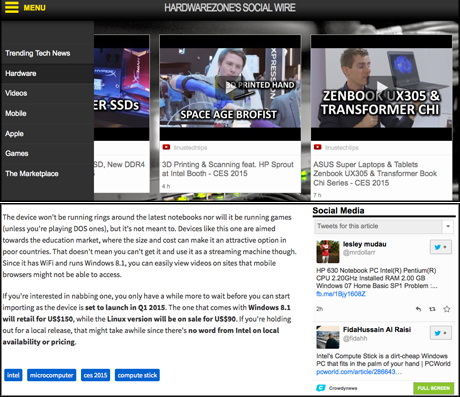
Social media curation platform Crowdynews has received €2.5 million [£1.9 million] in funding from Singapore Press Holdings, one of the largest media companies in Asia, and investment firm INKEF Capital.
Crowdynews, which launched in 2010, provides publishers with customisable social media feeds on article pages to complement stories.
"We believe that the future of publishing will have to incorporate social media in the content," Chua Boon Ping, chief executive of the Singapore Press Holdings (SPH) New Media Fund, told Journalism.co.uk over email.
Many of SPH's 19 titles already use Crowdynews software, said Chua, and the platform's co-founder Edwin Kuipers explained that the funds would be used to further develop the product.
The social media feeds Crowdynews provides can be customised to include specific accounts and topics, or automated, using natural language processing software to understand an article's subject and pull in tweets or other social media posts relevant to the issue.

Screenshot from HardwareZone.com, an SPH title, showing 'fullscreen' curated streams around particular topics (top), and beside an article
"The media business is always about engaging the audience and Crowdynews complements the strong editorial content that SPH has by bringing in the social media element from the audience," said Chua. "This makes the content even more relevant as real-time feeds on the various topics are presented side by side with the publishers' own content."
Crowdynews widgets have been used by American publisher Digital First Media since 2012, but the company has recently developed the product to include "all known social media" said Kuipers, and make the readers' experience of the widgets more interactive.
Kuipers described social media as "real-life illustrations... crucial to storytelling", but when readers visit an article page from social media the 'bounce rate' – the percentage of readers who leave without visiting another page – is far higher than among those from other sources.
He believes this is because of the different "mood" many news sites have compared to social networks, describing the reader trajectory from social to news platform as like "plunging into cold water".
"We're looking into what we call 'socialising' the reader's experience," he told Journalism.co.uk. "So when they go to news from the social environment they don't really leave their mood, so to speak, and they stay in the same environment."
- Crowdynews will be speaking at February's news:rewired conference at a session on engaging younger audiences. Tickets are now sold out, but there are still places on three special news:rewired+ training courses on February 4.
Free daily newsletter
If you like our news and feature articles, you can sign up to receive our free daily (Mon-Fri) email newsletter (mobile friendly).
Related articles
- Journalists are happy to be disconnecting from platforms, should news organisations be worried?
- Protecting journalists on social media, with Valérie Bélair-Gagnon
- What will your audience want in the future?
- 15 free sources of data on the media industry
- Predictions for journalism 2024: social media platforms and strategies









